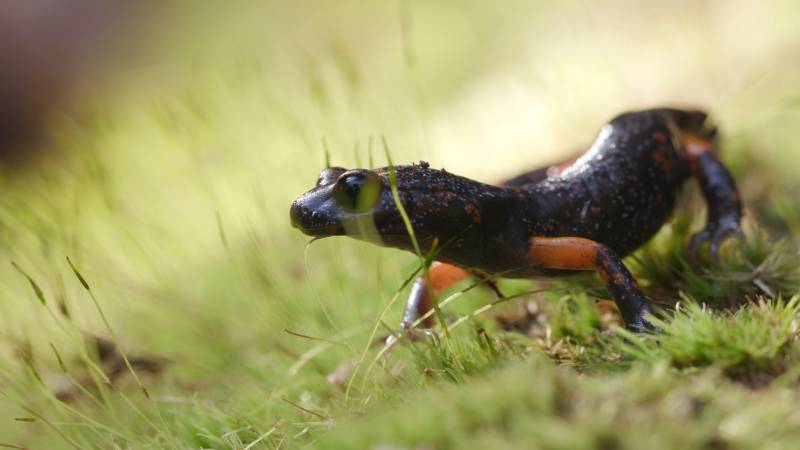Ensatina Salamanders Are Heading For a Family Split
Graduate student Regina Spranger walked just off the path on the UC Santa Cruz campus and flipped a log over to reveal a reddish-brown salamander.
She picked up the squirmy amphibian, about as long as her hand, and revealed a translucent orange underbelly.
“There’s an egg right there, see it?” Spranger said.
The startled critter, a yellow-eyed ensatina, is more than a colorful campus local. It is also an example of what researchers say is “evolution in real time” — not something that happened millions of years ago and recorded in a dusty textbook, but instead a living, breathing demonstration of how species change to adapt and prosper in their surroundings.
The little yellow-eyed salamander is one subspecies of a sprawling clan of highly variable ensatina salamanders that have evolved an extraordinary range of strategies for avoiding predators.
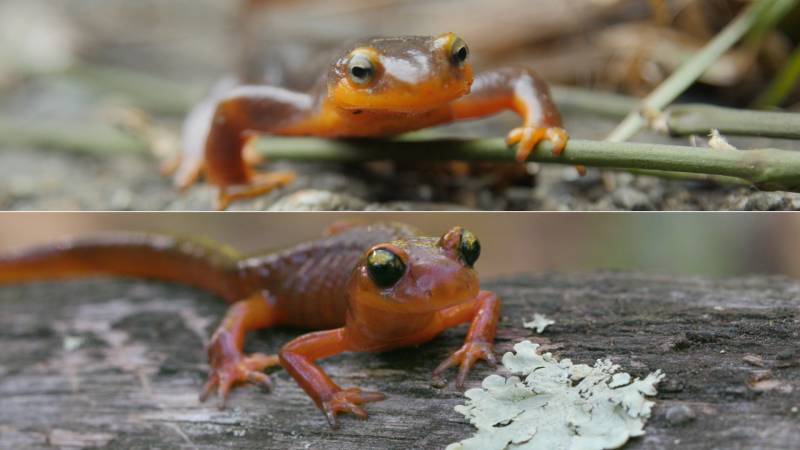
This type evolved its yellow eyes and brightly colored belly to look very much like the California newt — its extremely toxic neighbor in these Northern California forests. Amazingly, when threatened by a predator, the yellow-eyed subspecies even mimics the anti-predator behavior of the newts — arching its back, and walking slowly — as if to say “eat me at your own risk.” But if a scrub jay or a garter snake were to actually test their luck and swallow an ensatina, these phonies might be a sticky mouthful, but harmless to the predator.
It turns out that the trick of mimicking its toxic neighbor is only one anti-predator strategy they have evolved over the millennia. Some varieties of ensatinas along the California coast developed convincing camouflage to seamlessly blend in with their surroundings, while others in the Sierra Nevada mountain range adopted disruptive patterning — displaying high-contrast splotches of color to break up the outlines of their bodies against the forest floor.
Spranger is collecting individuals like this one and housing them temporarily (before rereleasing them) at UC Santa Cruz’s Coastal Science Campus. During COVID-19 times, the “army of undergraduates” that usually help out are not on campus, so she has been the only one caring for the animals, heading to the lab daily, dutifully tracking their complicated feeding and watering charts pasted to the doors of the climate-controlled rooms.
Spranger, and her adviser, ecologist Barry Sinervo at UC Santa Cruz, are studying the effects of climate change on ensatina behavior. The species is a favorite for scientists studying how animals adapt and evolve for good reason.
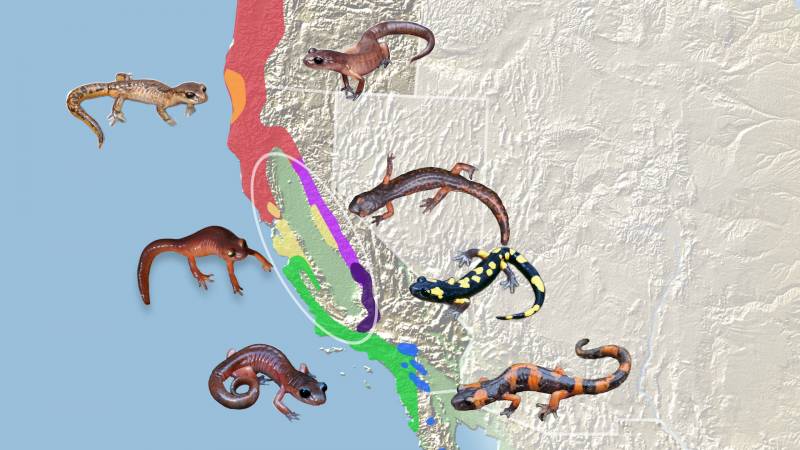
Though they form a motley crew spread out across the Western coastal states and sporting different colors and behaviors, they are still considered one species. That is because all types of ensatinas are able to mate and have offspring with each of their neighbors.
But when researchers look more closely, the two types of ensatinas at the southern tips of their range — the Monterey ensatina and the large-blotched ensatina — only rarely mate and have offspring where their populations overlap. Some combination of genetic differences, habitat preference and behavior are keeping the lineages separate.
This makes ensatina salamanders a rare example of a “ring species” — an animal that spread and adapted around a geographic barrier — in this case, California’s dry Central Valley — only to come back together millions of years later as near strangers.
A ring species like the ensatina is unique in that it neatly illustrates the rich story of evolution — an idea that English biologist Charles Darwin and others have supported with countless studies over the past 161 years, since Darwin published his landmark book “On the Origin of Species.”
Typically, the in-between versions of species die out long before we can observe them. Although most species only provide pieces of the story, a ring species reveals more of the steps it has taken along the evolutionary path. “Extinction has not done it’s dirty deed on the ensatina yet, so that we see a lineage in full bloom,” said biologist David Wake, of UC Berkeley, who has studied ensatinas for over 50 years.
“If extinction had come along for them, we’d argue about who was the closest relative of whom and who has evolved from what. But here we see they’re all part of the same fabric — that’s what’s so unusual about a ring species.”
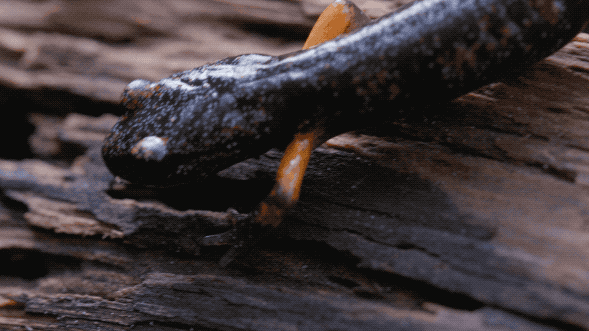
It is rare to find a real-time glimpse of how one species becomes many, so evolutionary scientists like Wake and Sinervo are looking at ensatinas to build on Darwin’s original ideas about how species form; and as a way to help understand biodiversity all across the planet.
Wake encourages his students not to get stuck on the concept that species are fixed entities that suddenly spring into existence. “There’s almost an element of magic in the way some people think about species,” he said. When looking at a species, Wake sees “a continuum of change” — a kind of collage of ancestral lineages, flowing in a river of time.
The eclectic family tree of the ensatina also provides an insight into our own recent evolution.
“I think humans are really a wonderful example of long-term changes in species through time and across space,” Wake said. “As the lineage has evolved, we’ve picked up useful genes from Neanderthals, from Denisovans and probably from other groups we have yet to learn about.”
Six million years ago, around the time the human lineage (Homo sapiens) split from chimpanzees, ensatinas had already been developing variations within their own species, adapting to their habitats and predators.
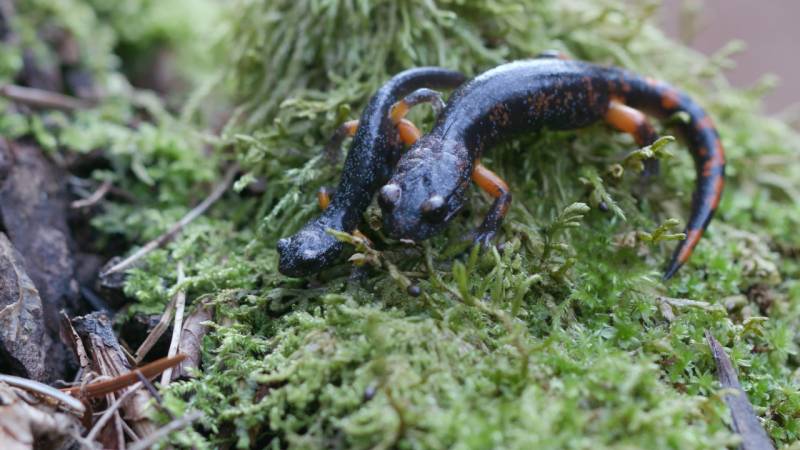
Since 1859, when Darwin published “On the Origin of Species,” his ideas of natural selection and how species form have stood the test of time. Darwin had a broad understanding of species formation: that they form gradually over time.
“We think that Darwin’s way of looking at things was really pretty much spot on,” Wake said, “and we don’t see any reason to question that.”
But today, because of generations of research into animal behavior, ecology and genetics, scientists have a much more complete picture of the complex forces at play in evolution, and how it relates to biodiversity — the incredible variability of life on Earth.
Darwin introduced the idea that some species survive and some would go extinct through a process of competition among individuals in the environment, but he had not tackled the question of why our planet is home to such an astonishing array of life-forms.
“He knew he had only a partial view,” Wake said. “You never get just two individuals sort of competing head-to-head with each other. You have to think about all of the other things they’re doing and all the other organisms they’re interacting with.”
For Sinervo, the story of the ensatina embodies the complex forces that give us biodiversity on Earth.
Over millions of years, the yellow-eyed ensatinas interacted with California newts, which they mimic. At the same time, the newts were also co-evolving with garter snakes and birds, predators that learned newts are toxic, which in turn reinforces the success of the yellow-eyed ensatina’s disguise.
Other types of local ensatinas (like the more cryptic Monterey ensatina) co-evolved with birds and snakes as well, but using a different strategy — stealth. All of these forces are continuously at play, balancing against each other as the species’ branch and evolve over time.
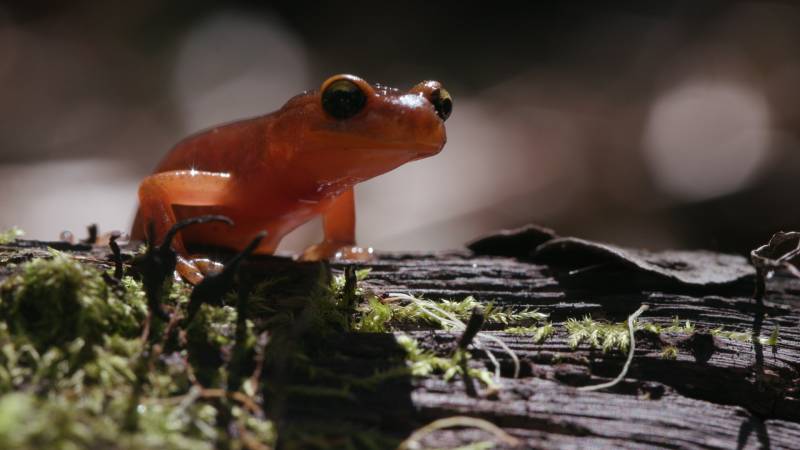
“We need historical perspective. You wouldn’t understand anything about ensatinas unless you understood the 15 million years of evolution and co-evolution with newts.”
It’s less a one-on-one competition, and more like the dynamic of the game “rock, paper, scissors” where more players have a chance to win, resulting in a more diverse system. “That game stabilizes the whole ecosystem,” Sinervo said.
The big mystery of ensatinas, evolution and biodiversity is only partially solved. But one issue researchers tend to agree on is that change is inevitable. “Change itself is a constant,” Wake said. The big challenge for scientists, is that “when you look at a species, the minute you take your attention away from it, it’s changed a little bit.” Like the ensatina, you just can’t pin a species down. They are as squirmy with their identity as they are in person.
There is still so much more to discover, he adds, even after devoting half a century of research to the ensatina. For example, there is a lot that scientists do not know about how and why the ensatina developed their varied mimicry system, and they only have a basic understanding of what is keeping the two southern-most ensatina types apart in the places they overlap. Also, a Mexican biologist recently found the salamanders in coastal lava tubes at the southern-most tip of the ensatina range in Baja California, despite them being mostly “a mountain animal that is supposed to be adaptively colored. What’s it doing at sea level where it gets maybe six, seven inches of rain a year? That’s absolutely crazy.”
But instead of keeping him up at night, these unanswered questions are why he stays fascinated by his work.
“I despise textbooks because instead of saying what’s not known, they always say, ‘This is it,’” Wake said. “I want to know the real stuff, I want surprises.”
Further viewing:
To learn more about Barry Sinervo’s work, check out Deep Look’s episode from a few years back: “These Lizards Have Been Playing Rock-Paper-Scissors for 15 Million Years”
